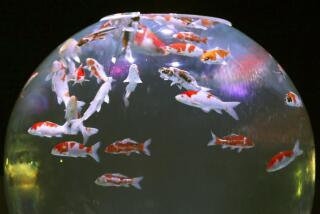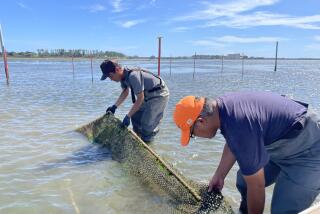In Japan, Nothing Beats the Heat Like Eel
- Share via
TOKYO — It’s another hot summer in Tokyo. The sun burns like a furnace in the sky, and Tokyoites trudge down city sidewalks, sopping the sweat off their foreheads with handkerchiefs.
All that discomfort gives Katsunori Tanaka a hunger for one thing: a big bowl of grilled eel over rice.
“I need stamina and I think eating eel makes me feel better,” Tanaka, 35, a salesman, said after wolfing down a serving with his colleagues near Tokyo’s biggest fish market.
The uninitiated might consider the slithery creatures -- anguilla japonica, or “unagi” in Japanese -- an unappetizing meal.
But the Japanese for centuries have considered eel a sure-fire cure for heat fatigue.
And with the mercury hitting record levels in Tokyo this summer, the eels -- filleted, grilled and slathered in a sugar, soy and rice wine sauce -- are flying out of the kitchens.
Takao Inoue, manager at Haibara, a popular eel take-out shop near the Tsukiji fish market, can attest to that. He grilled a mind-numbing 400 eels one Friday and estimates that he’s sold 30% more this summer over last year.
“When the weather is hot, sales go up,” he said after a long, hot day at work.
This summer in Japan fits the bill. On July 20, the temperature in central Tokyo hit 103.1 -- the hottest day on record in the capital since the Meteorological Agency began keeping statistics in 1923.
Sales of eel are up nationwide. Naoko Ueda, spokeswoman for one of Japan’s largest supermarket chains, Aeon, said sales during the traditional weeklong peak were 30% higher this year than last, which was unseasonably cool.
The freshwater eel, which grows about 20 inches in length, is rich in vitamins A, B1, B2, D and E. Its high protein content is also good for bodies weary in hot, humid weather.
The eel’s popularity in Japan goes way back.
“Manyoshu,” a collection of poetry believed to have been published during the 8th century, includes a poem praising the eel as a way of preventing weight loss in summer.
Unagi got a major boost with a nifty 18th century marketing ploy.
Eel legend says well-known Japanese naturalist Gennai Hiraga told an eel dealer that he could boost sales by putting up a sign urging customers to eat the creatures on “Doyo no Ushi Day” -- a traditional summer benchmark denoting 18 days before the beginning of autumn under Japan’s ancient calendar. This year, there are two: July 21 and Aug. 2.
“It was not that Hiraga had any scientific proof that eel was good,” said Junji Natsume of the fish farmers co-op in Lake Hamana, a major eel-producing area in central Japan.
“It had been commonly thought that eel was nutritious and good for those who suffered summer heat. So once the sign was put up, people bought it,” he said.
These days, most of the eel going down Japanese gullets comes from abroad.
Japanese production plummeted by 50% since 1991 to 24,569 tons in 2003 in the face of cheaper imports. Some 80% of the eel consumed in Japan is imported, mostly from China and Taiwan.
At the retail level, however, that doesn’t matter much.
For a seller like Inoue, all he’s counting on is the weather -- nice, hot, sweaty, eel-eatin’ weather.
“I hope it doesn’t rain,” he said.
More to Read
Sign up for Essential California
The most important California stories and recommendations in your inbox every morning.
You may occasionally receive promotional content from the Los Angeles Times.










